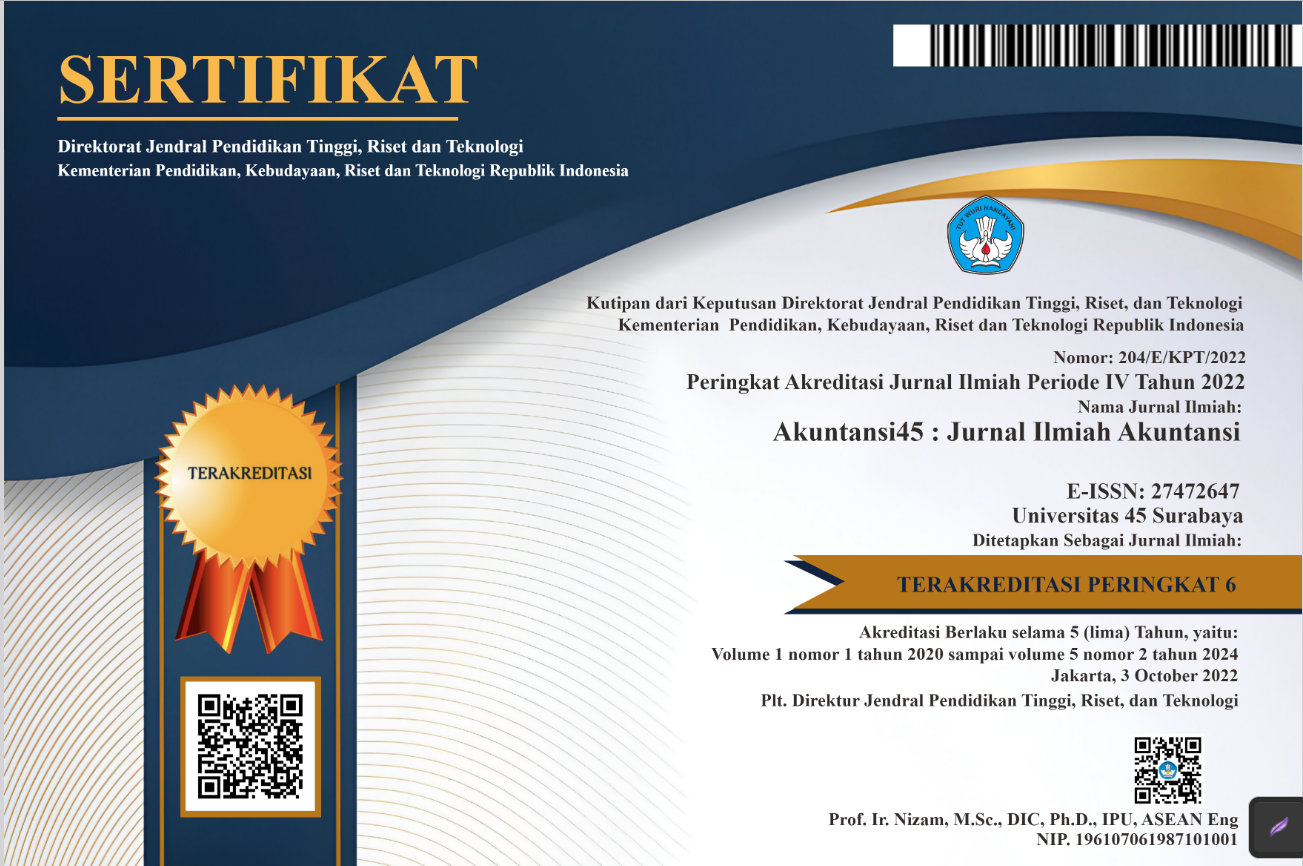Analisis Faktor-Faktor Yang Mempengaruhi Penggunaan E-Commerce
(UMKM Kota Sukabumi)
DOI:
https://doi.org/10.30640/akuntansi45.v4i2.1852Keywords:
Cost efficiency, Innovation, True, e-commerceAbstract
Developments in the field of technology as well as advances in the business world have encouraged Micro, Small and Medium Enterprises actors to innovate in services related to the use of e-commerce technology. This research was conducted with the aim of examining whether each of the factors of cost efficiency, innovation and trust affect the tendency of MSMEs to adopt e-commerce. Data collection was carried out using a questionnaire with sample selection using a purposive sampling method, namely SMEs in Sukabumi City. The analysis used using quantitative methods. The test results show that each of the cost efficiency factors has a negative effect on the use of e-commerce and the innovation factor has a positive effect on the use of e-commerce and also the trust factor has a positive effect on the use of e-commerce. Questionnaires are distributed directly to MSMEs and focused SMEs that use e-commerce. This study did not conduct in-depth research on each application of the variables tested. With this research, MSMEs are more aware and concerned about the importance of e-commerce in their business because currently people prefer to shop online
References
Acep Suherman, Tina Kartini, Elan Eriswanto, Gatot Wahyu Nugroho, Evi Martaseli, Idang Nurodin, Choiffudin Muclis, H. T. (2021). buku panduan skripsi akuntansi 2021 (5th ed.). 2021.
BPS. (2021). PERTUMBUHAN EKONOMI (Issue 07).
Day, J. (2015). Determinant Factors of E-commerce Adoption by SMEs in Developing Country: Evidence from Indonesia. Procedia - Social and Behavioral Sciences, 195, 142–150. https://doi.org/10.1016/j.sbspro.2015.06.423
Ghozali. (2018). Aplikasi Analisis Multivariate Dengan Program IBM SPSS 25 (ke 9). UNDIP.
Gustyana, T. T. (2019). Efisiensi Biaya dan Keuntungan Pada Bank Domestik Yang Termasuk LQ45 dan Bank Asing. Jurnal SIKAP (Sistem Informasi, Keuangan, Auditing Dan Perpajakan), 3(2), 98. https://doi.org/10.32897/jsikap.v3i2.117
Jugiyanto. (2008). Analisis dan Desain Sistem Informasi: Pendekatan Terstruktur Teori dan Praktek Aplikasi Bisnis. 69–73.
Rahmad Solling Hamid, M. I. (2017). Analisis Dampak Kepercayaan Pada Pengguna. 3, 310–337.
Rerung, R. R. (2018). e-commerce menciptakan daya saing sistem informasi (p. 194). CV BUDI UTAMA.
Rosdani, M. R. (2022). Modul E-Commerce (W. Afrida (ed.); 1st ed.). Mitra Cendikia Media.
Shen, W. (2017). Understanding Chinese users’ switching behaviour of cloud storage services. The Electronic Library, 35(2), 214–232. https://doi.org/10.1108/EL-04-2016-0080
Sugiyono. (2017). Metode Penelitian Kuantitatif, Kualitatif dan R&D (26th ed.). ALFABETA, cv.
Sukmadi. (2016). Inovasi & Kewirasahaan (Pertama). Humaniora Utama Press.
Trijumansyah, A. (2019). Analisis Kepercayaan dan Kualitas Situs pada Minat Beli Produk E-Commerce Bukalapak. Business Innovation and Entrepreneurship Journal, 1(2), 72–81. https://doi.org/10.35899/biej.v1i2.55
Wibowo, T. (2014). Analisis Efisiensi Biaya terhadap Keputusan Penggunaan Outsourcing Bidang Cleaning Service dan Catering pada PT Kuwera Jaya Jakarta. The Winners, 15(1), 34. https://doi.org/10.21512/tw.v15i1.634









